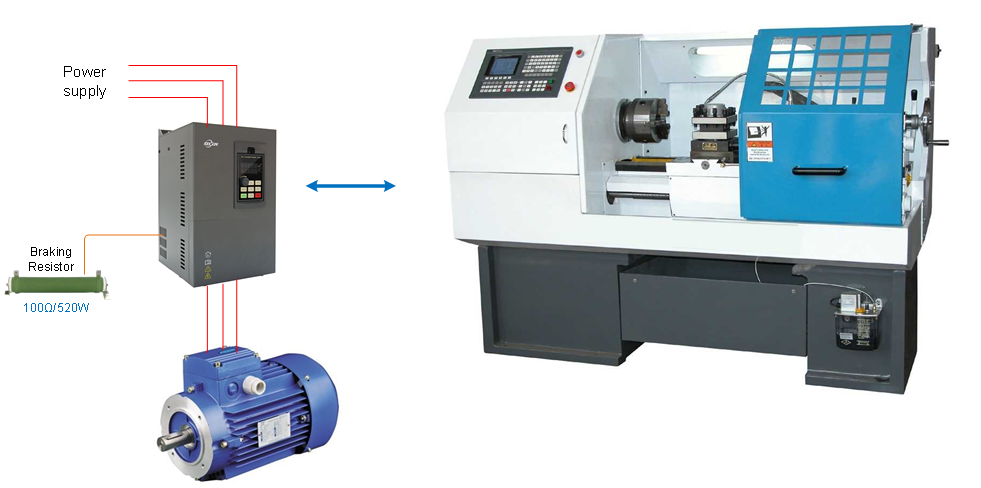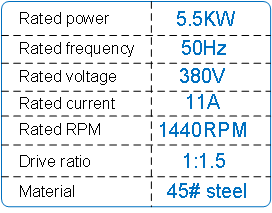Case Study 
Application of Kecen AC drive in CNC Machine Tool
Introduction
Digitally controlled machine tools, referred to as NC or Numerical Control Machine Tools, it is an integrated electromechanical product with mechanical, electrical, hydraulic, pneumatic, microelectronics, and information technology in the past three decades, in the modern machine tool production process, it adopts multi-motor driven, and the main shaft and each feed system are driven by their respective motors. Since the machine tool has a wide processing range, different workpieces, different procedures, and different tools are used, the machine tool's executive parts are required to have different moving speeds, so the main movement of the machine tool should be able to adjust the speed. The spindle speed control system generally uses an AC spindle system with the development of variable frequency speed regulation technology, the AC drive of the spindle of CNC machine tools can also meet the needs well. The main drive motor drives the main shaft to rotate through a belt drive, or the main shaft rotates through a belt drive and a reduction gear in the headstock (for greater torque). Due to the wide range of spindle motor speed adjustment and stepless speed adjustment, the structure of the spindle box is greatly simplified.
I. CNC machine tool system requirements:
(1) Motor requirements
Usually requires a variable frequency motor, or an ordinary motor plus a fan to meet the heat dissipation requirements of the motor at low frequencies, and requires a wide range of motor speed.
(2) Technical requirements of the inverter
A: Requires large torque at low-frequency
The vector control mode is used, and it can output 150% of rated torque at low frequency (1~10Hz).
B: The torque dynamic response speed is fast, and the stable speed accuracy is high.
Selecting a vector control inverter can achieve a very good dynamic response. According to the change of the load, it can respond quickly through the change of the output torque, so as to achieve the stability of the shaft speed.
C: Fast deceleration and stop
Generally, the acceleration and deceleration time of CNC machine tools is relatively short. The acceleration time depends on the performance of the inverter. The deceleration time depends on the external braking resistor or braking unit.
D: Auto-tuning of motor parameters
After selecting a vector inverter, to achieve good control performance, it is usually necessary to perform parameters auto-tuning on the motor. The purpose is to obtain accurate internal parameters of the motor for vector control calculation. The motor nameplate parameters required for parameter auto-tuning are: motor rated power, motor rated frequency, motor rated speed, motor rated voltage, and motor rated current. Some inverter motors may not have the rated speed on the nameplate. You can estimate the rated speed based on empirical values. When performing parameter auto-tuning, be sure to perform it at no load (no load on the motor shaft). Only at no-load can the accuracy of the self-learned motor parameters be guaranteed.
If there is no way to carry out no-load operation on site conditions, you can consider using the frequency inverter default parameters to run the motor and check it performance.
E: Frequency command and running command
The frequency command and running command of the inverter used on CNC machine tools are come from the CNC controller. Generally, there are two types of channels given, one is analog, the other is multi-step speed, or both. Given at the same time, priority is given to multiple speeds. Analog setting is mainly based on voltage type, and also current type. The inverter can compatible with both types of analog quantities.
2. Anti-interference problem
The inverter has a good anti-interference test when before leaving the factory, it has strong anti-interference ability, but the inverter is also a source of interference itself. It is difficult to avoid interference to other equipment during operating. The interfered device is a CNC controller. Once the CNC controller is disturbed, the system will not work properly. In particular, the frequency command and running command of the inverter may also be disturbed. Serious interference may cause the frequency command to be unstable, and the inverter may malfunction. The solution to this problem is to add a magnetic ring to the output cables of the inverter to reduce high-frequency radiation. Generally imported CNC has strong anti-interference ability.
The following uses the application of KC510 series high-performance vector inverter in a CNC machine tool factory in Shenyang (China) as an example to describe the frequency inverter performance in CNC machine tools.
System composition:
KC510 inverter, braking resistor (100Ω / 520W), speed regulating motor, CNC system:


Actual test performance specifications:
(1) Spindle speed: 200r / min (inverter operating frequency 9~10Hz)
(2) Spindle speed: 450r / min (inverter running frequency is about 22Hz)
3. KC510 series inverter features:
KC510 series high-performance vector control inverter uses the latest DSP chip for high-speed motor control. The motor has large torque at low speed, high speed accuracy, reasonable price, and complete functions. Mechanism to ensure that the motor runs at the highest efficiency. Therefore, using the KC510 series high-performance vector control inverter instead of the spindle AC servo system is the best choice for the machine tool industry. KC510 series inverter has the following characteristics:
(1) The latest DSP for high-speed motor control is used to ensure fast response of vector control.
(2) The modular design of the hardware circuit ensures stable and efficient operation of the circuit.
(3) The appearance design combines international design concepts, with smooth lines and beautiful appearance.
(4) The structure adopts independent air duct design, the fan can be disassembled freely, and the heat dissipation is good.
(5) Open-loop vector control, close-loop vector control, torque control, V/f control can be selected.
(6) Powerful input and output multi-function programmable terminals, high speed pulse input, two analog outputs.
(7) The unique "excavator" adaptive control feature automatically limits the upper limit of the motor torque during operation, effectively suppressing frequent trips due to overcurrent.
(8) Wide voltage input range, automatic voltage regulation (AVR), instantaneous power failure without stopping, stronger adaptability.
(9) built-in advanced PID algorithm, fast response, strong adaptability, simple commissioning process; 16 steps speed control, simple PLC to achieve multi-function logic control such as timing, fixed speed, a variety of flexible control methods to meet various complex working condition requirements.
(10) Built-in international standard MODBUS RTU ASCII communication protocol. Users can control the host computer through PC / PLC to realize centralized control of inverter 485 communication network.
4. Commissioning results:
In the real system’s operation, it has proved that the use of KC510 series high-performance vector inverter can fully meet the requirements of machine tool spindle control. KC510 uses the latest DSP chip for high-speed motor control to ensure fast response of vector control. It can output 150% of torque smoothly even at low speed (low frequency) to meet the processing requirements of different parts. It can completely replace the traditional rolling bearing spindle Structure, and the spindle structure is simple and compact, which can realize the real stepless speed regulation. The output speed of this spindle is controlled by external analog signals. Different processing speeds (such as roughing and finishing) require different speeds. At this time, the CNC system can output different analog voltage signals to the inverter. Different speeds are realized, and the start and stop signals are also controlled by the CNC system, which increases the degree of automation and extends the service life of the tool.
5. Conclusion:
The traditional CNC machine tool systems are generally use AC servo system, imported brand vector control inverters, and variable speed motors, the total system cost is very expensive; KC510 series inverters are unique in their performance, stable operation, high accuracy, large output torque at low-frequency, complete protection functions, high reliability, easy operation and maintenance, etc., and superior cost-effective performance, it was quickly recognized and accepted by the market in the application of CNC machine tools.
6. The main characteristics of the Kecen inverters:
(1) Large output torque at low-frequency, stable output;
(2) High-performance vector control;
(3) Fast torque dynamic response and high stability speed accuracy;
(4) Fast deceleration and stop;
(5) Strong anti-interference ability.










 2019-03-06
2019-03-06 Browse Times:
Browse Times:
 Back to list
Back to list

